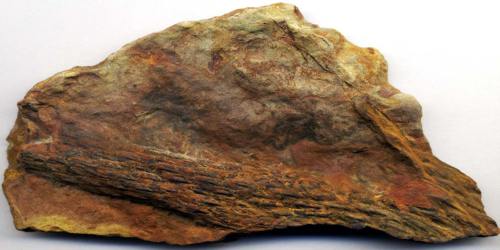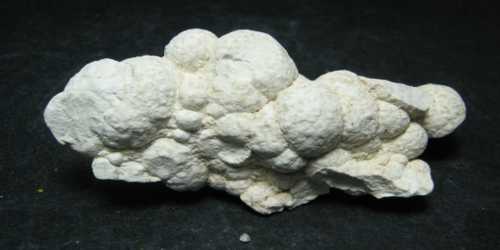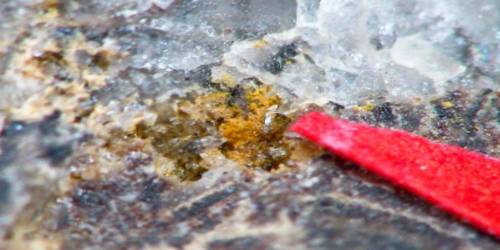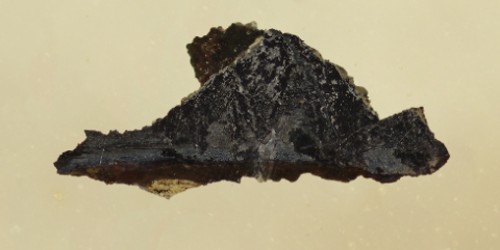Definition –
Siltstone is a clastic sedimentary rock composed mainly of silt-sized particles. It forms where water, wind, or ice deposit silt, and the silt is then compacted and cemented into a rock. As its name implies, it is primarily composed (greater than 2/3) of silt-sized particles, defined as grains 2-62 μm or 4 to 8 on the Krumbein phi (φ) scale. Siltstones differ significantly from sandstones due to their smaller pores and higher propensity for containing a significant clay fraction. Although often mistaken as a shale, siltstone lacks the fissility and laminations which are typical of shale.
Siltstones may contain concretions. Unless the siltstone is fairly shaly, stratification is likely to be obscure and it tends to weather at oblique angles unrelated to bedding. Mudstone or shale are rocks that contain mud, which is material that has a range of silt and clay. Siltstone is differentiated by having a majority silt, not clay.
Silt accumulates in sedimentary basins throughout the world. It represents a level of current, wave, or wind energy between where sand and mud accumulate. These include fluvial, aeolian, tidal, coastal, lacustrine, deltaic, glacial, paludal, and shelf environments. Sedimentary structures such as layering, cross-bedding, ripple marks, erosional contacts, and fossils provide evidence of these environments.
Color –
Siltstone generally are red and gray color with flat bedding planes. Darker colored siltstone have plant fossils and other carbon-rich matter. It is hard and durable and do not easily split into thin particles or layer. Although often mistaken as a shale, siltstone lacks the fissility and laminations which are typical of shale. Siltstones may contain concretions. Unless the siltstone is fairly shaly, stratification is likely to be obscure and it tends to weather at oblique angles unrelated to bedding. Mudstone or shale are rocks that contain mud, which is material that has a range of silt and clay. Siltstone is differentiated by having a majority silt, not clay.

Composition and Formation-
Siltstone is much less common than sandstone and shale. The rock units are usually thinner and less extensive. Only rarely is one notable enough to merit a stratigraphic name. It is composed primarily of angular silt-sized particles (0.0039 to 0.063 mm (0.00015 to 0.0025 inch) in diameter) and is not laminated or easily split into thin layers. Siltstones, which are hard and durable, occur in thin layers rarely thick enough to be classified as formations.
Identifying siltstone and shale requires distinguishing between silt and clay particles.Silt and clay are both tiny particles that have weathered away from rocks and minerals. Silt is intermediate in size between the larger grains of sand and the smaller clay particles. To be classified as silt, the particles must be smaller than .06 millimeters in diameter, (.002 inches) and larger than clay-size particles, which are smaller than .004 millimeters in diameter (.0002 inches). Clay, unlike silt, also refers to several types of minerals, including montmorillonite and kaolinite.
Siltstones are intermediate between sandstones and shales but are not so common as either. They contain less alumina, potash, and water than shales but more silica; in addition to mica, they may contain abundant chlorite and other micaceous clay minerals. Although many shales contain more than 50 percent silt, not all are siltstones; siltstones differ from these shales in that they commonly are chemically cemented and show such features as cross-bedding (i.e., lamination inclined to the main bedding plane), cut-and-fill structures, and flowage within a layer. See also mudstone.
Sources of Siltstone –
Siltstone is deposited in a similar environment with shale but is usually located near the old delta, lake or seashore, where calm currents cause less particle suspension. Siltstone is generally formed adjacent to sandstone deposits close to beaches and delta edges where sand is deposited. It consists of silt, hence siltstone, sandy beaches, and water adjacent to deltas. Declining currents filter sand from smaller silt particles. Siltstone rises to the shale level in deep water; where the suspended clay particles are stored further as the currents continue to lose energy. In both cases, calm water is needed to suspend and separate silt and clay. Thus, sandstone, siltstone, and shale are interrelated rocks which are distinguished by particle size.
Uses of Siltstone –
Siltstone has very few uses. It is rarely the target of mining for use as a construction material or manufacturing feedstock. The intergranular pore spaces in siltstone are too small for it to serve as a good aquifer. It is rarely porous enough or extensive enough to serve as an oil or gas reservoir. Its main use is as a low-quality fill when better materials are not locally available.
Information Sources:
















